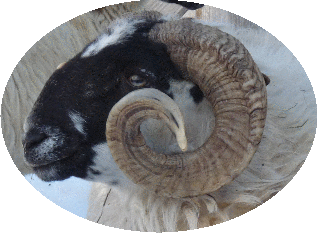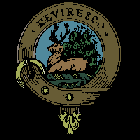
HOME | home
Maxwell 3
MORE MAXWELL HISTORICAL INFORMATION
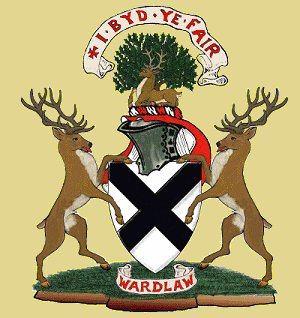
' THE ARMS OF THE LORDS MAXWELL OF CAERLAVEROCK,
THE CHIEF OF THE MAXWELL NAME.'
Motto- REVIRESCO
I Grow Green or I flourish again,
Second Motto-I bid ye fair
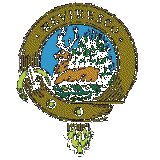
Maxwell Clan Badge
A stag Proper, attired Argent, couchant before a holly bush Proper.
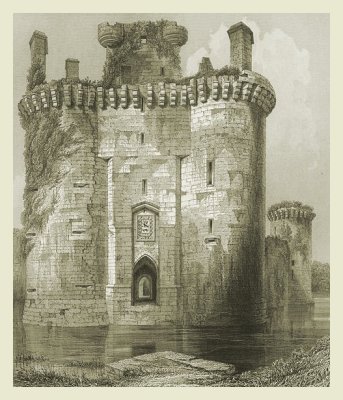
The Maxwells are a Border clan and were active during the turbulent Border wars. The first leader was Maccus, son of Undweyn who lived in the 12th Century who appears to have given his name to Maccuswell, a pool of the Tweed near Kelso Bridge; Wael is old English for pool. His descendant Sir John Maxwell was appointed Chamberlain of Scotland but died without issue in 1241. He was the first to occupy the Maxwell's great castle of Caerlaverock. He was succeeded by his brother Sir Aymer who had two sons, Herbert and John. From these two brothers descend many branches of the Maxwell clan. Sir Herbert of Maxwell was one of the nobles who recognized Margaret of Norway as Queen of Scots and John Balliol as King. His grandson,Sir Eustace held Caerlaverock for Edward I in 1312 but later signed The Decalaration of Arbroath in 1320. He returned to Balliol's camp briefly but then followed the Bruces, his brother and son also followed David II to the field in 1346.Herbert his successor was knighted Lord Maxwell afterJames I return in 1424 and he became increasingly more powerful during the 15th century after the decline of the Black Douglases and became Warden of the Marches. John, Lord Maxwell in the reign of King James IV was imprisoned for lawlessness but later died with his King at Flodden in 1513. He had two sons, Robert, 5th Lord and John who became Lord Herries of Terregles by marrying Lady Anne Herries. His brother served briefly as Regent during King James V's reign and escorted Queen Mary of Lorraine to Scotland in 1538. In 1581, John, Lord Maxwell was created Earl of Morton after the execution of the Douglas holder, he was killed in an engagement with the Johnstons in 1593. His son also John, in revenge killed Sir James Johnston of that Ilk in 1608 and fled to the continent, only to be executed on his return in 1613. He was succeeded by his brother Robert who was created Earl of Nithsdale (the title of Earl of Morton was restored to the Douglases). The title reverted to Lord Herries when the direct line ended. The 5th Earl joined the Jacobite Rising of 1715 and was captured and sentenced to death, he escaped from the Tower of London dressed in female attire and then he escaped to Rome where he was forced to live in poverty until his death. Other Maxwell families include those of Pollock, Monreith, Cardoness and Corruchan. William Maxwell of Corruchan established in Lyon Court his claim as heir male of the Maxwells.
Click the stag here for Lord Maxwell's Last Goodnight a ballad
about the feud between the Maxwells and the Johnstones
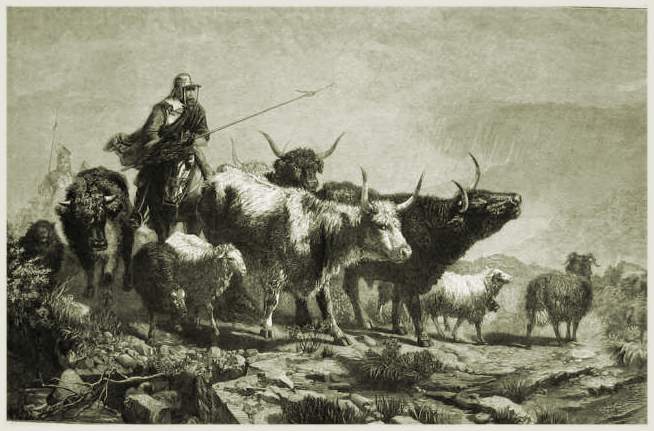
The Story of the Anglo-Scottish Border Reivers
by George Macdonald-Frase
"The Steel Bonnets" chronicles the life of families who lived in the border region of England and Scotland during the 13th to 17th centuries. The lawless conditions gave rise to many instances of feuds, robbery, plunder and even murder. There are many references to the Maxwell families who lived in this region. "The Steel Bonnets" is available for sale through amazon.com , or may be obtained through inter-library loan.
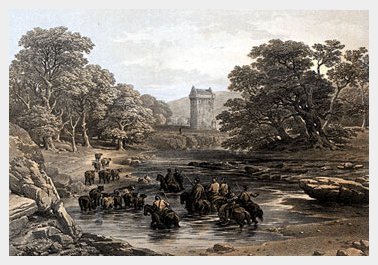
ROWAN
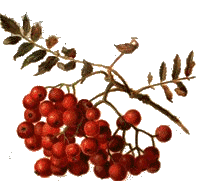
The Maxwell Family plant badge
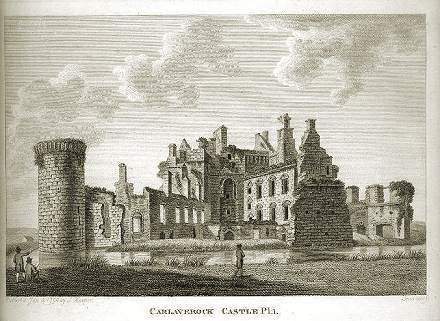
Nithsdale in southwestern Scotland, meaning "valley of the new river" was occupied by the Maxwells. The 10th Lord Maxwell became the Earl of Nithsdale when he surrendered the title of Morton, which had been given to them after the execution of the regent, Morton. There were apparently only 8 Earls of Nithsdale (they held the title less than a century - from 1620 to 1716), all Catholic, and whose support vacillated from the English to the Jacobites. The story of the rescue of the fifth Earl of Nithsdale, William, by his wife from the Tower of London the day before his execution is very well known. He had been jailed and sentenced to death for his part in the Jacobite rebellion. The Countess confused the guards with a 'flurry' of women attending her in to see her husband and departing with her. The guards paid no mind, apparently, to her final departure with the Earl disguised as a woman. They did not realize that one more woman came out of the room than had gone in.
The Earls of Nithsdale intermarried twice into the House of Traquair. Charles married Lady Mary Maxwell, who was the daughter of the 4th Earl of Nithsdale. A generation later, Catherine Stuart, daughter of the 6th Earl of Nithsdale, married the Earl of Traquair.
The sixth Earl of Nithsdale (son of the escaped Jacobite and of his enterprising Countess) married Catherine Stuart, daughter of the fourth Earl of Traquair (who himself had married a sister of the fifth Earl of Nithsdale, mentioned above). Through his marriage Traquair, the oldest inhabited house in Scotland, passed to the Maxwell-Stuarts when the direct line of Stuarts of Traquair died out in 1875 with the 99-year-old Lady Louisa Stuart, daughter of the seventh Earl of Traquair and sister of the eighth and last Earl.
Sept Names

Adair, Blackstock, Cardoness, Dinwiddie, Dinwoodie, Edgar, Farnham,
Herries, Kirk, Kirkland, Latimer, Latimore, Mackittrick, Maxton, Mescall,
Monreith, Moss, Nithdale, Paulk, Peacock, Pollock, Pollok, Polk, Sturgeon, Wardlaw
Maxwell, Dr William (1760 — 1834)
Second son of James Maxwell of Kirkconnell, he was educated at the Jesuit College at Dinant in France, and became a doctor. While on the Continent, he developed Republican opinions, becoming a member of the National Guard. In this capacity, he was present at the execution of Louis XVI, dipping his handkerchif in that unfortunate monarch's blood. In 1794, he returned to Scotland and settled in Dumfries, where he met Burns. Because of his Jacobin leanings, he was viewed with some suspicion by the authorities but his professional skill overcame these difficulties, and he eventually became a much respected practitioner. Maxwell attended Burns during his last illness, diagnosing the stabbing agonies of endocarditis as 'flying gout' and prescribing sea- bathing in country quarters and horseriding; 'cures' which probably hastened Burns's end. Shortly before his death, the poet presented Maxwell with his pair of Excise pistols, which are now in the Museum of the Scottish Society of Antiquaries. Jean Armour Burns called the son born to her on the day of her husband's funeral Maxwell, after the doctor, who attended her.
Together with Cunningham and Syme, Maxwell became one of the Trustees who collected money for a fund to ensuree that Burns's widow and children did not want.
Burns last son named after Dr. Maxwell, Burns's youngest child, born on the day of his father's funeral, and called Maxwell after the doctor who had attended both his father and mother. He is buried in the Mausoleum.
For more information on more Maxwells and Robert Burns see:
After being apprenticed to a joiner, Maxwell set up in business for himself, with the profits of which he bought back the family estate of Terraughty, previously sold because of financial difficulties. Later, he also bought Portrack, in the Parish of Holywood. By his second marriage, he came to own Munches. When Burns settled in Dumfriesshire, Maxwell was a well known county figure. For his 71st birthday, Burns wrote him an epistle, beginning 'Health to the Maxwells' Veteran Chief!'
In the second stanza Burns prophesied:
"This day thou metes threescore eleven,
And I can tell that bounteous Heaven.
(The second-sight, ye ken, is given
To ilka Poet)
On thee a tack o' seven times seven,
Will yet bestow it."
Bounteous Heaven certainly went some way towards fulfilling the poet's prophecy for
'teugh Jockie', as Burns called Maxwell in the first of Heron Election Ballads, lived to be 94.
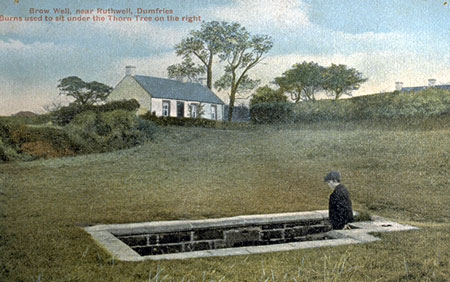
Brow Well
Click the stag here for Lord Maxwell's Last Goodnight a ballad
about the feud between the Maxwells and the Johnstones
POLLOCK AND MAXWELL
JOHN F. POLK
CLAN POLLOCK HISTORIAN
FROM THE POLLAG, JUNE 2000
There is an ancient association between the Pollock and Maxwell families. They have been allied since the 12th century through marriage, feudal bonds, military alliance and simple physical proximity within the Barony of Pollok in Renfrewshire.
This association is the reason for Clan Pollock selecting its tartan as a variant of the Maxwell tartan. Like any enduring, real relationship, fact and myth has become irretrievably mixed in the mists of time so there will never be a complete or final telling of this story. Nonetheless, the basic outline of the Pollock and Maxwell association is known with some certainty and we present a brief account here, hopefully without adding to the confusion.
Both families trace back to the time of David I, King of Scotland. David, whose mother Margaret was a daughter of Edward the Exile of England, was sent as a youth to the English Court and learned the Norman feudal system of lords and vassals at first hand. When he later became King, David began to institute a similar system in Scotland and invited a number of the Norman families into his court, investing them with lands, mostly in the Scottish lowland and border areas, which they held as vassals to himself as overlord and sovereign. The best known of these are of course the Stewarts and Bruces who eventually rose to kingship themselves. Many of the great families of Scotland, some but not all of Norman lineage, trace their origins back to this time. The Pollocks and Maxwells are among them.
The principal Pollock (Polloc) line of descent from Fulbert, which had lordship over Upper Pollock, became known as Polloc-of-that-Ilk to distinguish it from other Pollock lines (Pollock of Belgray, Pollock of Hatton). This lineage is described in detail in Crawfurd’s History of the Shire of Renfrew, and a transcription of his text appeared in the previous issue of The Pollag. The hereditary name of “de Polloc” was certainly in use by 1208. A seal of that date may be found in the British Museum with the words “Sigillum Roberti de Polloc” inscribed about the family emblem - a wild boar.
The progenitor of the Maxwell family was Undewyn, or Undwain, a Saxon lord, who lived in the area of Kelso by the River Tweed. Like our Fulbert, little is known of him - just than he was the father of Maccus from whom the family name of Maxwell derives. “Wael” is a pool or whirlpool and “Maccus Wael” referred to the site along the Tweed where they dwelled. Maccus is much better know than his father and was cited in various charters and donations such as the donation by David I of the lands of Melrose Abbey where he appears as “Maccus filius Undwain”. The Maxwell family was prominent in the Scottish court and sometime after 1200 Sir John de Maccuswell, grandson of Maccus, was granted the lands of Carlaverock in Nithsdale which in due course became the principal seat of the Maxwell family. In the 15th century the head of this branch was granted the title Lord Maxwell and in the 17th they were given the title Earl of Nithsdale - and there is a long and bloody history behind this occurrence.
One branch of the Maxwells was granted lands in Renfrewshire around 1270 and the close association between the descendants of Fulbert and of Undwain begins at this time. The early history is described in “Memoirs of the Maxwells of Pollock” by Sir William Fraser as follows:
(The lands of) Pollok formed part of the extensive estates which were granted by King David I to Walter the High Steward about the year 1124. The grant of David was confirmed by his grandson, King Malcolm IV, in 1157-58. A part of the lands of Pollok, forming the upper division, appears to have been bestowed by the High Steward on Peter, son of Fulbert, who was one of his followers, and whose immediate descendants adopted the territorial designation of Pollok. They were vassals of the Steward, who continued to be the Superior of Upper Pollok. This superiority was acquired by Rolland de Mearns, along with the barony of Mearns, and afterwards by the Maxwells of Carlaverock, on their succeeding Rolland. The Polloks of Upper Pollok thus became vassals of the Maxwells as Lords of Mearns, and this vassalage continued until the seventeenth century.
The lower division of Pollok, commonly called Nether Pollok, was, about the year 1270, given by Sir Aymer Maxwell to his younger son, Sir John Maxwell, whose territorial designation thenceforth became of Pollok, or of Nether Pollok, and whose lineal male descendant is the present Sir John Maxwell of Pollok.
Thus the Maxwells of (Nether) Pollock and the Pollocks of that Ilk, of upper Pollock, were near neighbors in Renfrewshire and of equal stature as vassals to the Maxwells of Carlaverock. With this physical and social proximity it was inevitable that there would be strong ties, and at time strong rivalries, between these families over the centuries. It cannot be said that the relationship was always rosy - there were feuds and conflicts. In fact the lands of Polloks of that Ilk were confiscated by Robert the Bruce in 1314, because of their adherence to Baliol and support of Edward I, and assigned to Sir John Maxwell of Carlaverock. However these were restored in due course with the marriage of Robert de Polloc and Agnes, daughter of Sir John Maxwell of Carlaverock, sometime prior to 1372. The lineal descendants of Pollock-of-that Ilk until quite recently have held some portion of these lands. Later descendants of this line can thus claim both Fulbert and Maccus as ancestors.
The course of Scottish history was very turbulent and bloody over succeeding centuries until the Act of Union in 1707 provided the basis for a more stable and peaceable relationship with England, though things didn’t completely settle down until after the Battle of Culloden in 1746. The Maxwells were the dominant family in the Western Marches of the frontier and major participants in the border reiver conflicts of the 16th century. Their castle at Carlaverock was a key stronghold during this period and the inevitable focus of military stratagems and outright battles. The Polloks and Maxwells of Renfrewshire were certainly involved in supporting the Maxwells of Carlaverock in their ceaseless struggles in the border wars but we have little specific information on this. It has been cited in Crawfurd and other histories how Polloks fought with the Maxwells for Queen Mary at Langside, 1568, and against the Johnstones at Lockerbie, 1593.
During the plantations of Ulster in the 17th century, both Maxwells and Pollocks can be found transplanted into various locations in the North of Ireland. The lowlands of Scotland, especially Ayrshire and Renfrewshire, were a primary source of recruits for such settlements, so this is to be expected. Their names can be found sporadically in muster rolls, hearth rolls, church records and other documents of 17th century Ulster, but there is no authoritative genealogical treatment of their connections with the families back in Scotland. Unambiguous records of descent from that era are sparse and widely dispersed so it is not likely that this will change anytime soon. In fact, looking at surviving records such as those published in the volumes of the Scottish Records Society it becomes clear that there were a large number of Pollocks and Maxwells scattered throughout Scotland and Ulster, not all of whom can be assigned to the principal family lines. Nonetheless, considering the recent explosion of interest in genealogy and the growth of information processing technology, we may hope that long buried information may continue to emerge and shed new light on our ancient family ties.
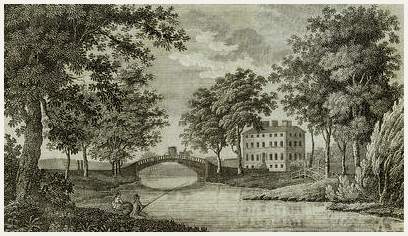 References:
A General Description of the Shire of Renfrew, George Crawfurd, 1710; revised by George Robertson, 1818
Memoirs of the Maxwells of Pollok, Sir William Fraser
The Book of Carlaverock, William Fraser, 1873
A History of the County of Renfrew, Wm. Metcalfe, DD, 1905
Old Days and Ways in Newton Mearns, A. Boyd Scott, 1939
Eastwood District History and Heritage, Thomas C. Welch, 1989
The Surnames of Scotland, George F. Black, 1993
The Steel Bonnets, George MacDonald Fraser, 1971
Pollock Letters, Queries and Notes, from letters notes, documents and pedigrees collected together by Alex Pollock of 1939, compiled by E. A. Langslow Cock and enlarged by the late Kennet Pollock, 1996
Maxwell Arms
|
Resources and References
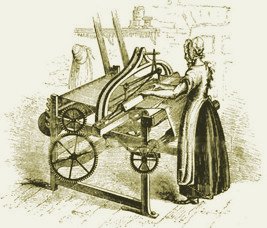

The Glasgow That I Used To Know
- Adam McNaughtan
Jim and Beth Boyle
3680 Panama-Stedman Road
Mayville, NY 14757
USA
Phone 716-789-5804

